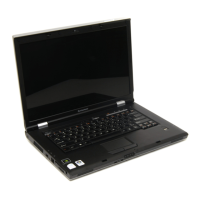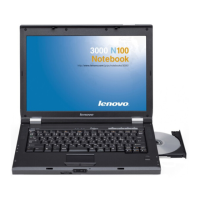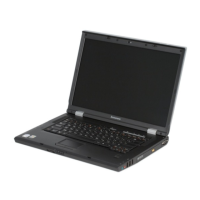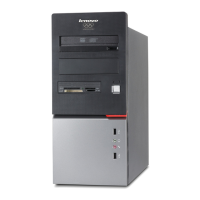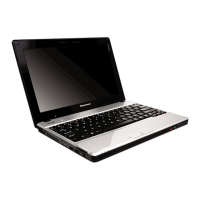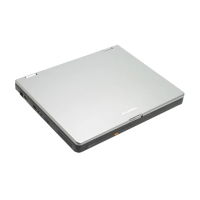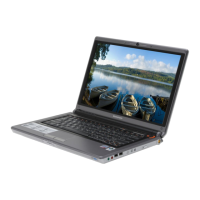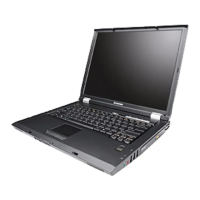Do you have a question about the Lenovo 3000 N500 and is the answer not in the manual?
Rules to ensure general safety when handling computer equipment.
Rules for working safely on electrical equipment.
Checklist to identify potentially unsafe conditions before servicing.
Precautions for handling parts sensitive to electrostatic discharge.
Importance of electrical grounding for safety and system function.
Safety warnings provided in multiple languages.
Compliance information for laser products.
Strategy to prevent unnecessary expenses for FRU replacement and servicing.
Recommendations for replacing a hard disk drive.
Precautions for handling and replacing sensitive system boards.
Guide on using error codes for diagnosing failures.
FRU replacement strategies for specific product configurations.
Guidelines for replacing RoHS compliant parts.
Information required for FRU parts exchange and warranty coverage.
Procedures for identifying and correcting computer problems.
Instructions for using PC-Doctor for DOS diagnostics.
Overview of PC-Doctor for Windows troubleshooting features.
Procedures for diagnosing power system issues.
Steps to restore system to factory state using recovery discs.
Information on power-on, hard-disk, and supervisor passwords.
Explanation of screen blank, sleep, and hibernation modes.
Index to match symptoms and errors with FRU replacement actions.
Details on processors, standard and optional memory.
Specs for hard disk drives and optical drives.
Details on I/O ports, Ethernet, modem, Bluetooth, and wireless LAN.
Specs for graphics, display, audio, camera, and touch pad.
Details on AC adapters and preinstalled operating systems.
Meaning of the blue drive in-use status indicator light.
Meaning of Caps Lock, Num Lock, and Scroll Lock status indicators.
Meaning of wireless status indicators (purple, orange, blue, blinking blue).
Meaning of battery status indicators (blue, blinking blue, orange, blinking orange, off).
Meaning of the blue Power on status indicator.
Applicable tests for the system board FRU.
Applicable tests for the LCD unit FRU.
Applicable tests for the keyboard FRU.
Applicable tests for the hard disk drive FRU.
Applicable tests for the diskette drive FRU.
Applicable tests for memory FRUs.
Fn+F1/F2 for volume, Fn+F7/F10/F11 for display.
Fn+F5 for wireless, Fn+F12 for hibernation, Fn+Esc, Fn+Ins/Del, Fn+PgUp/Dn, Fn+cursors.
Important notices regarding the use and tightening of screws.
Procedure to save and restore the system serial number after board replacement.
Information on the Universally Unique Identifier (UUID) and its assignment.
Procedures for reading and writing ECA information from EEPROM.
General guidelines for removing and replacing FRUs.
Precautions for handling the sensitive system board.
Identification of components on the front view of the laptop.
Identification of components on the rear view of the laptop.
Identification of components on the bottom view of the laptop.
Comprehensive list of all FRUs and their details.
Specific parts list for LCD components.
List of available keyboards by language.
List of miscellaneous parts like screws and cables.
List of available AC adapters.
List of available power cords by region.
List of recovery discs for different operating systems.
List of common tools used for servicing.
Rules to ensure general safety when handling computer equipment.
Rules for working safely on electrical equipment.
Checklist to identify potentially unsafe conditions before servicing.
Precautions for handling parts sensitive to electrostatic discharge.
Importance of electrical grounding for safety and system function.
Safety warnings provided in multiple languages.
Compliance information for laser products.
Strategy to prevent unnecessary expenses for FRU replacement and servicing.
Recommendations for replacing a hard disk drive.
Precautions for handling and replacing sensitive system boards.
Guide on using error codes for diagnosing failures.
FRU replacement strategies for specific product configurations.
Guidelines for replacing RoHS compliant parts.
Information required for FRU parts exchange and warranty coverage.
Procedures for identifying and correcting computer problems.
Instructions for using PC-Doctor for DOS diagnostics.
Overview of PC-Doctor for Windows troubleshooting features.
Procedures for diagnosing power system issues.
Steps to restore system to factory state using recovery discs.
Information on power-on, hard-disk, and supervisor passwords.
Explanation of screen blank, sleep, and hibernation modes.
Index to match symptoms and errors with FRU replacement actions.
Details on processors, standard and optional memory.
Specs for hard disk drives and optical drives.
Details on I/O ports, Ethernet, modem, Bluetooth, and wireless LAN.
Specs for graphics, display, audio, camera, and touch pad.
Details on AC adapters and preinstalled operating systems.
Meaning of the blue drive in-use status indicator light.
Meaning of Caps Lock, Num Lock, and Scroll Lock status indicators.
Meaning of wireless status indicators (purple, orange, blue, blinking blue).
Meaning of battery status indicators (blue, blinking blue, orange, blinking orange, off).
Meaning of the blue Power on status indicator.
Applicable tests for the system board FRU.
Applicable tests for the LCD unit FRU.
Applicable tests for the keyboard FRU.
Applicable tests for the hard disk drive FRU.
Applicable tests for the diskette drive FRU.
Applicable tests for memory FRUs.
Fn+F1/F2 for volume, Fn+F7/F10/F11 for display.
Fn+F5 for wireless, Fn+F12 for hibernation, Fn+Esc, Fn+Ins/Del, Fn+PgUp/Dn, Fn+cursors.
Important notices regarding the use and tightening of screws.
Procedure to save and restore the system serial number after board replacement.
Information on the Universally Unique Identifier (UUID) and its assignment.
Procedures for reading and writing ECA information from EEPROM.
General guidelines for removing and replacing FRUs.
Precautions for handling the sensitive system board.
Identification of components on the front view of the laptop.
Identification of components on the rear view of the laptop.
Identification of components on the bottom view of the laptop.
Comprehensive list of all FRUs and their details.
Specific parts list for LCD components.
List of available keyboards by language.
List of miscellaneous parts like screws and cables.
List of available AC adapters.
List of available power cords by region.
List of recovery discs for different operating systems.
List of common tools used for servicing.
| Bus type | FSB |
|---|---|
| Stepping | M0 |
| Tjunction | 100 °C |
| Processor cache | 1 MB |
| Processor cores | 2 |
| System bus rate | - GT/s |
| Processor family | Intel Pentium Mobile |
| Processor series | Intel Pentium T3000 Series for Mobile |
| Processor socket | Socket 478 |
| Processor codename | Merom |
| Processing Die size | 143 mm² |
| Processor frequency | 2.16 GHz |
| Processor cache type | L2 |
| Processor lithography | 65 nm |
| Processor manufacturer | Intel |
| Processor front side bus | 667 MHz |
| Processor operating modes | 64-bit |
| ECC supported by processor | No |
| Thermal Design Power (TDP) | 35 W |
| CPU multiplier (bus/core ratio) | 13 |
| Number of Processing Die Transistors | 291 M |
| HDD speed | 5400 RPM |
| HDD interface | SATA |
| Card reader integrated | Yes |
| Total storage capacity | 250 GB |
| Display surface | Matt |
| Display diagonal | 15.4 \ |
| Display resolution | 1280 x 800 pixels |
| Native aspect ratio | 16:10 |
| Type | PC |
| Modem speed | 56 Kbit/s |
| Wireless technology | IEEE 802.11a/g/n |
| Memory slots | 2x SO-DIMM |
| Internal memory | 2 GB |
| Internal memory type | DDR2-SDRAM |
| Maximum internal memory | 4 GB |
| Memory layout (slots x size) | 2 x 1 GB |
| Audio system | Conexant CX20561-12Z |
| Speaker power | 2 W |
| Networking features | Ethernet/Fast Ethernet |
| Operating system installed | Windows Vista Business |
| Number of battery cells | 6 |
| Charging port type | DC-in jack |
| Serial ports quantity | 0 |
| USB 2.0 ports quantity | 4 |
| Cable lock slot type | IBM |
| Pointing device | Touchpad |
| Discrete graphics card model | Intel® GMA 4500MHD |
| Processor code | SLB3P |
| Processor ARK ID | 35583 |
| Depth | 256.5 mm |
|---|---|
| Width | 358.5 mm |
| Height | 37 mm |
| Weight | 2740 g |

